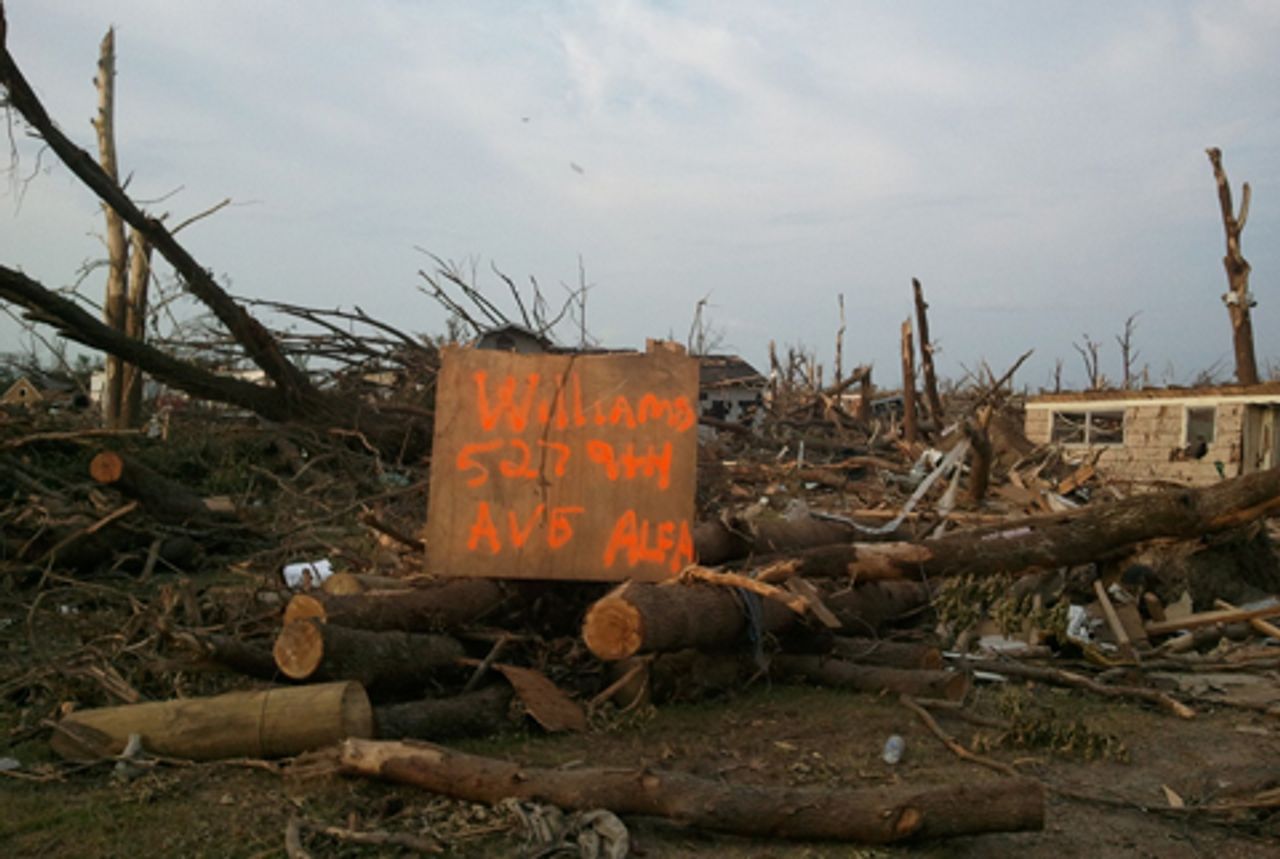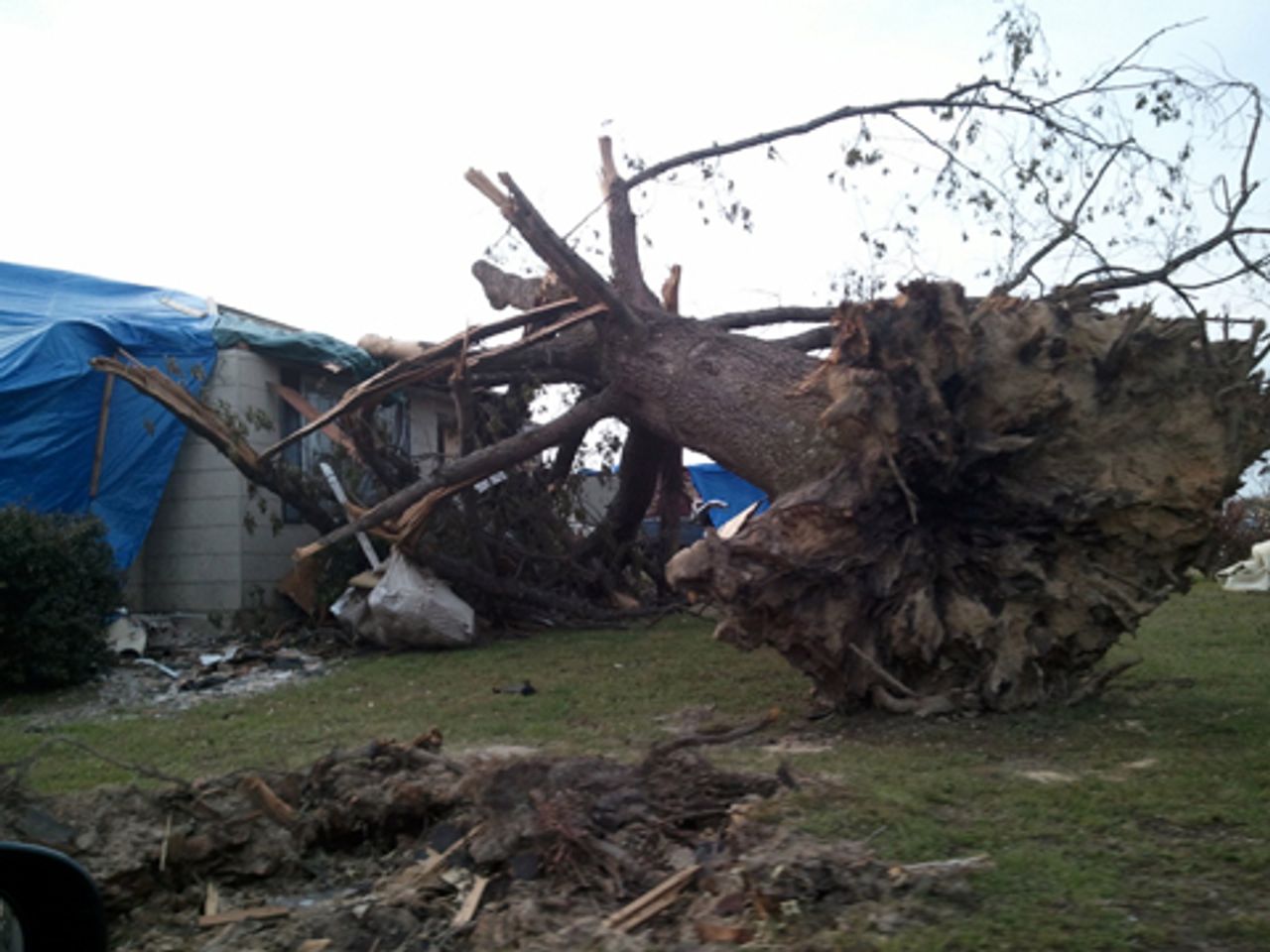 Sign marking residential address in devastated Pleasant Grove, Alabama
Sign marking residential address in devastated Pleasant Grove, AlabamaAt approximately 6 p.m. Wednesday, April 27, my father, mother and brother were taking cover in the lowest level of their home in Pleasant Grove, Alabama. Taking similar precautions in my Birmingham apartment, I was glued to the radio. The announcer described devastation unfolding at that very moment in my family’s immediate vicinity.
A few moments later, from my apartment window, I was able to see a tornado estimated at a half-mile wide move almost calmly by, making its way towards Fultondale and leaving a path of destruction in its wake. For a suspense-filled half hour I was unable to reach my family on their cellular phone.
Upon finally getting through, I was assured that they were safe but “it was bad.” People were crying and screaming in the streets. Pleasant Grove had been nearly demolished.
The death toll is now estimated at 350 people across six states, more than two thirds here in Alabama. In a recent article by the Associated Press, journalists Greg Bluestein and Holbrook Mohr lament, “The death toll from Wednesday’s storms seems out of a bygone era, before Doppler radar and pinpoint satellite forecasts were around to warn communities of severe weather. Residents were told the tornadoes were coming up to 24 minutes ahead of time, but they were just too wide, too powerful and too locked onto populated areas to avoid a horrifying body count.”
To an extent, this is accurate. The amount killed from these storms certainly seems from a time less technologically advanced. But to say warning was given only minutes before is not factual. People were told days before that a potentially dangerous weather system was heading this way. So why are we seeing such a large death toll?
In the aftermath of such a catastrophe, it is both natural and necessary to question what could have been done to prevent such loss of life and property, and in the future implement the lessons learned.
An Alabamian my entire life, such storm systems are nothing new to me, particularly at this time of year. Indeed, on April 8, 1998, a tornado devastated some of the same small towns affected by the most recent storm, including Pickens/Tuscaloosa County and in Oak Grove, Jefferson County.
That year saw an F5 tornado. The Fujita scale measures tornados from F0 to F5. F5s have measurable winds in excess of 260 miles per hour.
The death toll from the 1998 storm was 32, with more than 250 injuries. More than 1,000 homes were destroyed and more than 900 homes had significant damage. That event surpassed the infamous tornado of March 21, 1932, which killed 31.
The path of destruction from the 2011 storms has already far exceeded these storms in loss of life and property.
 Uprooted and mangled trees collapsed on houses, streets, and power lines made rescue far more difficult.
Uprooted and mangled trees collapsed on houses, streets, and power lines made rescue far more difficult.No technology, as yet, can prevent the incredible destruction to property such a storm system wreaks. Yet it’s hardly news that underground storm shelters exponentially increase one’s chance of survival. Of the recommended steps given by FEMA (Federal Emergency Management Agency), when seeking shelter from a tornado they advise first, “Storm cellars or basements provide the best protection.“
Yet despite Alabama’s history of deadly tornado activity, there are very few storm shelters or basements in this area. Speaking as a longtime worker in the housing and construction business, generally one does not see them anymore. Most new homes are built on slabs. Even when realtors state that a home has a basement, that level is not actually underground or, at best, only underground on one edge of the house. This offers very little or no protection. Construction standards have not been devised from the standpoint of safety at all.
Moreover, when a potentially dangerous storm has been predicted residents should be given ample time to prepare. As it stands most businesses were open until minutes before it hit or even tried to work right on through it. If employees request to leave work early enough to get them and their loved ones to a safe place, those employees may be outright denied, or at minimum frowned upon. Workers fear this will place them higher upon the list of possible layoffs when the economy suffers. They are seen as lazy or foolish, or both. After all, not all tornado warnings come true.
In the aftermath of the devastation, the immediate response of local law enforcement actually hampered loss and relief efforts; affected communities were put under lock-down, even going so far as to barricade volunteer help out.
With emergency teams insufficient to handle a disaster of this scale, qualified civilians were prevented from assisting the weary first responders. Preoccupied with the supposed threat of looting and a breakdown of law and order, the decision was made to put property first and lives second. Yet among the victims, one would be hard pressed in finding someone who was more concerned about their belongings than saving lives and removing the rubble atop of their neighbors.
Rather than making personal safety a possibility for the average worker in an emergency situation, we are instead seeing outrageous attacks by Congress on such fundamental emergency preparedness organizations as the National Weather Service.
Last February, as tornado season approached, budget proposals backed by congressional Republicans called for a 30 percent reduction to the National Weather Service, more than $126 million in cuts. “In the next hurricane, flood, tornado or wildfire, lives will be lost, and people will ask what went wrong,” Dan Sobien, president of the National Weather Service Employees Organization, warned the Birmingham News at the time. The plans also included $1.5 billion in cuts for first responders “in disasters of mass destruction.” Additionally, the proposals call for the closing of local National Weather Service offices and furloughs of up to 27 days at a time for weather staffers.
As such cuts are now being negotiated between the Democrats and Republicans, there can be no doubt an agreement will be made that will further hamper the ability of the NWS to understand, predict and warn Americans.
“If liberty and equality, as is thought by some, are chiefly to be found in democracy, they will be best attained when all persons alike share in government to the utmost,” Aristotle pointed out a long time ago. The fact is that the only way the preservation of life will be considered primary, as opposed to the drive for profit, will be under socialism, genuine social equality and democracy.
When the profit motive is taken out of the calculations, storm shelters and homes built to last (rather than spit out almost as from an assembly line) will become the norm in a truly democratic society.
For now, survivors are left to sift through the remains of their life’s work and hope for a better day. People find hope in the simplest things during such a time, like a family photo that survived the destruction, a helping hand outreached, or the kindness of their neighbors.
From the storms of 1998 to today, ordinary working people from all around have come together to help one another piece things back together. That tragedies can reveal the awesome potential of humanity reveals how hindered we are by a system that keeps us preoccupied with the problem of the barest economic survival. This is perhaps the greatest tragedy of all.
